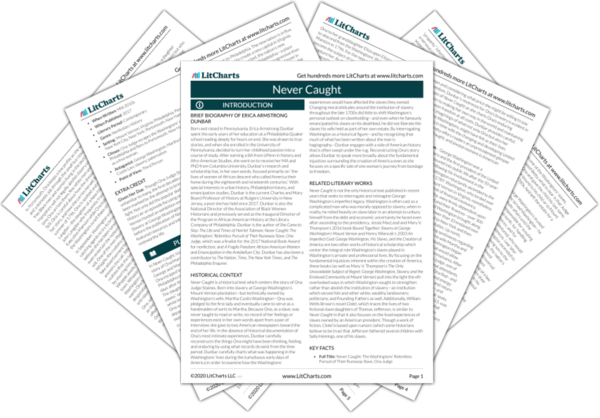Clothing symbolizes the unattainable wealth and freedom to which slaves like Ona Judge were constantly exposed but were hardly ever allowed to imagine for themselves. As Martha Custis Washington’s bondwoman, Ona dressed, readied, and pampered the first lady of the United States every day, brushing Martha’s hair and mending Martha’s muddied shoes and dresses. While this work wasn’t as laborious as the work of slaves who toiled in fields or kitchens, the material of Ona’s work—Martha’s finery—served as a constant reminder of the fact that she wasn’t (and might never be) free. Though Ona received considerably nice clothes of her own to wear while accompanying Martha on carriage rides, Dunbar demonstrates how Ona’s possession of material things associated with wealth, security, and freedom only reminded her of how distant she truly was from attaining those things.
Ona’s dresses—many of which she made herself—allowed her to adopt the trappings of luxury and freedom even as she remained enslaved. When Ona at last escaped to freedom from Philadelphia to New Hampshire, she brought along the fine dresses she’d made for herself—yet even as a woman living in a state where Black people could be free, she hardly ever wore them as she worked difficult jobs to support herself and her growing family. Ona knew that to seek work as a seamstress, she’d need to show off the things she’d made—but revealing her finery to the community could reveal her as the fugitive she was, destroying all the progress she’d made toward freedom. Clothing thus represents the ways in which Ona was limited as a Black woman, even after she escaped slavery.
Alongside Ona’s experiences, Dunbar also includes anecdotes about how the Washingtons’ other slaves attempted to elevate themselves by saving up rare gifts of money to purchase fine clothing and accessories such as hats and canes. Clothing, to these enslaved people, symbolizes the chance to change their circumstances. Yet because of cruel laws enforcing slavery (many of them enacted by George Washington himself) which held them in bondage, many surely knew that no matter how proximal they were to wealth and freedom, they’d never be able to fully enjoy such things. Clothing, then, symbolizes the painful, inescapable ways in which uncountable slaves in Ona’s position struggled toward freedom from bondage—and how, even once free, they continued to fight against the forces of racism and the danger of being dragged back into enslavement.
Clothing Quotes in Never Caught
Coming from a family of talented seamstresses, Judge was responsible for Martha Washington's appearance. She selected her gowns, made small repairs on aging skirts, removing stains whether they be from food or the dirt from the unpaved streets, and then dressed her. What appeared to be the mundane task of wardrobe selection for the first lady was actually quite important. A wardrobe lay at the root of one's appearance, and the mistress and her slave girl fashioned an image for the new American aristocracy.
But still, she was willing to face dog-sniffing kidnappers and bounty hunters for the rest of her life. Yes, her fear was consuming but so, too, was her anger. Judge could no longer stomach her enslavement, and it was the change in her ownership that pulled the trigger on Judge's fury. She had given everything to the Washingtons. For twelve years she had served her mistress faithfully, and now she was to be discarded like the scraps of material that she cut from Martha Washington's dresses. Any false illusions she had clung to had evaporated, and Judge knew that no matter how obedient or loyal she may have appeared to her owners, she would never be considered fully human.
The beautiful and expensive clothing that she wore to serve the Washingtons was packed away, and instead, Judge would have dressed in inconspicuous clothing, allowing her to hide in plain sight. She was a hunted woman and would try to pass, not for white, but as a free black Northern woman.
That Judge elected to become a domestic, that she chose to endure physically punishing work in New Hampshire, rather than remain a slave, says everything we need know about how much she valued freedom.
With no extra money to purchase a new wedding dress, Judge would have selected to wear something from her existing wardrobe. For months, the fugitive dressed inconspicuously, wearing plain clothing appropriate for a domestic. But on her wedding day she would have pulled out one of her nicer dresses, one that she used to wear while serving the Washingtons.












